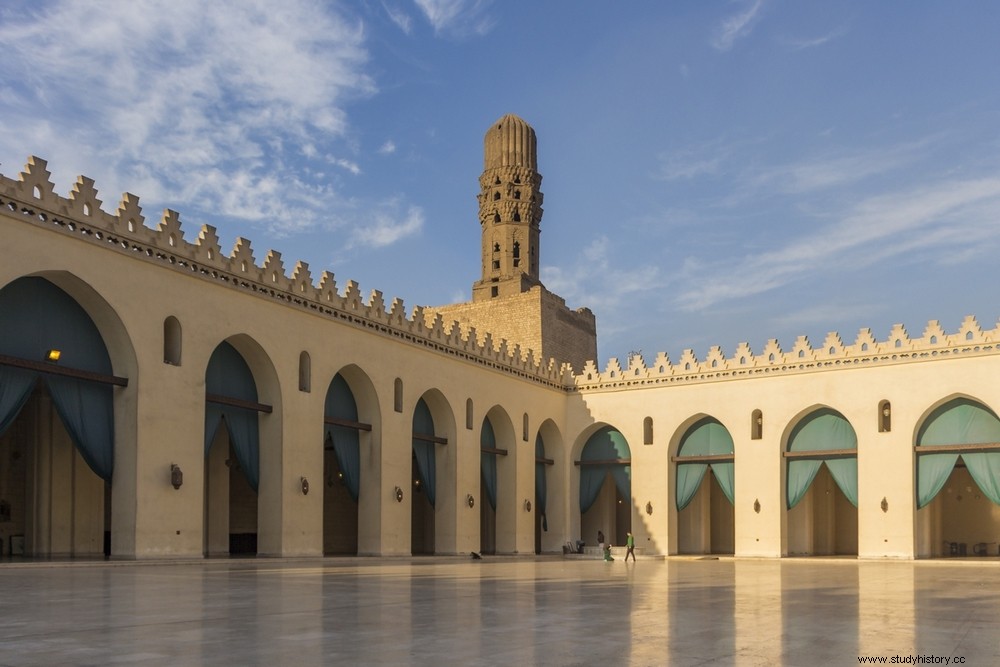Fatimid Princess, Sitt al-Mulk ( – ) assumes the regency when his half-brother dies after trying to seize power. Skillful regent, she put an end to the policy of terror of her predecessor and restarted the Fatimid empire.
Daughter of Caliph
Sitt al-Mulk was born in September 970 in al-Mansuriyya (near Kairouan in Tunisia). She is the daughter of a slave and of Prince Nizâr, son of the fourth Fatimid Caliph al-Muizz li-Dîn Allah. At the time of its birth and under the impulse of al-Mu'izz, the Fatimid caliphate conquered Egypt, founded the city of al-Qâhira (Cairo) and transferred its capital there. Sitt al-Mulk moved there when she was three and a half years old. Al-Muizz died in 975. His son, Sitt al-Mulk's father, succeeded him as Abu Mansur Nizar al-Aziz Billah.
Described as intelligent and beautiful, Sitt al-Mulk enjoyed a pampered and privileged childhood. His father loves him very much; he protects her by granting her close guard, having her build a palace and listening to her opinions. Usually, the Fatimid princesses are kept away from power, and devote themselves to charitable foundations as well as the construction of public or religious buildings. Sitt al-Mulk does not limit himself to this role. Introduced into the political circles of the palace, she influences the decisions of her father. Thus, in 989, she helped the vizier Ibn Nastûrus to return to his father's good graces.

Attempt to seize power
When Sitt al-Mulk was fourteen in 985, his half-brother al-Mansur was born to a Christian mother. Like the other Fatimid princesses, perhaps to avoid multiplying the pretenders to the throne, Sitt al-Mulk did not marry. She is dedicated to the political affairs of the Fatimid Empire.
After a reign of about twenty years, the Caliph al-Azîz died in October 996. Sitt al-Mulk was accompanied by courtiers who supported her and the palace guard, and returned in haste to the Caliph's palace at al-Qahira. She tries to occupy the place and influence the succession to the throne, perhaps to place a cousin there, but her attempt fails. She is stopped by the palace eunuch Barjawan, who places Sitt al-Mulk's half-brother on the throne. Al-Mansûr, who was only eleven years old, became the sixth Fatimid Caliph under the name of Al-Hakim bi-Amr Allah.
A reign of terror
It was under tutelage that the very young caliph began his reign. Sitt al-Mulk enters his good graces. According to her sources, she gives him many gifts and acquires great influence over him, as over her father previously. In the year 1000, the eunuch Bardjawân was assassinated and al-Hakim began to take his independence. The same year, he offered his half-sister land in Egypt and Syria and concessions generating significant revenues, which she managed through a personal administration.
The agreement between the caliph and his half-sister does not last. The caliph gradually puts in place strict and harsh laws, in particular towards the dhimmis , non-Muslim citizens. The assassinations of members of the elite, viziers, civil servants, but also ordinary citizens are increasing; as mistrust grew between Sitt al-Mulk and his half-brother, the latter also had some of his supporters executed. Tortures, murders, revolts crushed, the reign of the sixth caliph becomes a reign of terror.
A terror that also manifests itself in the personal life of al-Hâkim. In 1013, the sources indicate that he behaved with great violence towards the women of his harem. So much so that Sitt al-Mulk ended up intervening to take the umm al-walad under his protection. (slave who bore a son to his master) Rukayya and his son Abû ‘l-Hasan; she will educate her nephew herself. In response, al-Hâkim chose as his successor his cousin 'Abd al-Rahîm ibn Ilyas, governor of Damascus, rather than his son.
Regent of the Fatimid Empire
In February 1021, al-Hâkim disappeared during a nocturnal walk; five days later, his clothes were found pierced with stab wounds. Medieval sources accuse Sitt al-Mulk of having ordered the murder, but the account comes from an anti-Fatimid chronicler and the version is now widely disputed. Other contemporary sources do not hold the princess responsible for the disappearance of her half-brother.
Sitt al-Mulk wants to place his nephew and protege, Abu 'l-Hasan, on the throne. To get rid of the heir designated by the deceased caliph, the governor of Damascus, she invites him to return to Egypt where she has him imprisoned; he dies in prison. After which she ensures that her nephew becomes the seventh Fatimid caliph, under the name of al-Zâhir. The “Princess-aunt” (al-Sayyida al-‘amma ), as the sources call him, ensures the regency.
As regent, Sitt al-Mulk strives to redress the Fatimid empire after the chaos of her half-brother's reign of terror, but sometimes employs violent means herself, including political assassinations. It redresses the finances of the empire by canceling the multiple largesse lavished on its supporters by al-Hâkim, and restores suppressed taxes. In all respects, Sitt al-Mulk takes the opposite view of his half-brother's policy. It restores rights and freedoms that it had restricted, especially for women and dhimmis . It restores religious tolerance, allowing forcible converts to return to the first religion, as well as freedom for women to leave their homes.
Sitt al-Mulk died of dysentery in February 1023. After his death, for various reasons, the Fatimid Empire entered into crisis.
